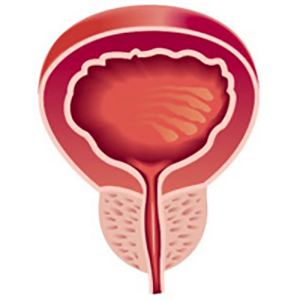Variation of inflammatory indexes in patients with chronic abacterial prostatitis treated with an herbal compound/extract

Accepted: May 11, 2023
All claims expressed in this article are solely those of the authors and do not necessarily represent those of their affiliated organizations, or those of the publisher, the editors and the reviewers. Any product that may be evaluated in this article or claim that may be made by its manufacturer is not guaranteed or endorsed by the publisher.
Introduction: Inflammation is a highly prevalent finding in the prostate. Men with inflammation have higher IPSS score and increased prostate size. For men with prostatic inflammation, there is a significantly increased risk of developing acute urinary retention and the need of a surgical approach to the disease. Some laboratory tests (i.e. fibrinogen, C-reactive protein), can play a role in identifying patients at greatest risk of complications and adverse outcomes after surgery. There have been several experiences exploring the role of nutraceutical approach to the prostate inflammation. Aim of our study were to describe the variation in symptoms and inflammatory indexes in men affected by chronic abacterial prostatitis, treated with an herbal extract containing Curcuma Longa 500 mg, Boswellia 300 mg, Urtica dioica 240 mg, Pinus pinaster 200 mg and glycine max 70 mg. Materials and methods: A prospective multicenter study was conducted from February 2021 and March 2022. One hundred patients, with a diagnosis of Chronic Prostatitis were enrolled in a multicentric phase III observational study. They were treated with the herbal extract, one capsule per day, for 60 days. No placebo arm was included. In each patient, inflammatory indexes, PSA, prostate volume, IIEF-5, PUF, uroflowmetry (Qmax), IPSS-QoL, NIH-CPPS were registered and statistically compared at baseline and at the follow up visit. Results: The variation obtained on the inflammation indexes showed a global improvement after treatment, including the PSA reduction. We also recorded a significant improvement on IPSS-QoL, NIH-CPPS, PUF and Qmax scores. Conclusions: The herbal extract considered in our study may represent a promising and safe therapeutic agent leading to a reduction of inflammation markers, and could be used in the treatment of prostatitis and benign prostatic hyperplasia.
Lloyd GL, Marks JM, Ricke WA. Benign Prostatic Hyperplasia and Lower Urinary Tract Symptoms: What Is the Role and Significance of Inflammation? Curr Urol Rep. 2019; 20:54. DOI: https://doi.org/10.1007/s11934-019-0917-1
Vasavada SR, Dobbs RW, Kajdacsy-Balla AA, et al. Inflammation on Prostate Needle Biopsy is Associated with Lower Prostate Cancer Risk: A Meta-Analysis. J Urol. 2018; 199:1174-1181. DOI: https://doi.org/10.1016/j.juro.2017.11.120
De Nunzio C, Voglino O, Cicione A, et al. Ultrasound prostate parameters as predictors of successful trial without catheter after acute urinary retention in patients ongoing medical treatment for benign prostatic hyperplasia: a prospective multicenter study. Minerva Urol Nephrol. 2021; 73:625-630. DOI: https://doi.org/10.23736/S2724-6051.20.04088-6
Gandaglia G, Briganti A, Gontero P, et al. The role of chronic prostatic inflammation in the pathogenesis and progression of benign prostatic hyperplasia (BPH). BJU Int. 2013; 112:432-41. DOI: https://doi.org/10.1111/bju.12118
Vela-Navarrete R, Alcaraz A, Rodríguez-Antolín A, et al. Efficacy and safety of a hexanic extract of Serenoa repens (Permixon®) for the treatment of lower urinary tract symptoms associated with benign prostatic hyperplasia (LUTS/BPH): systematic review and metaanalysis of randomised controlled trials and observational studies. BJU Int. 2018; 122:1049-1065. DOI: https://doi.org/10.1111/bju.14362
Wang Q, Zhu SR, Huang XP, et al. Prognostic value of systemic immune-inflammation index in patients with urinary system cancers: a meta-analysis. Eur Rev Med Pharmacol Sci. 2021; 25:1302-1310.
Alazawi W, Pirmadjid N, Lahiri R, Bhattacharya S. Inflammatory and Immune Responses to Surgery and Their Clinical Impact. Ann Surg. 2016; 264:73-80. DOI: https://doi.org/10.1097/SLA.0000000000001691
Paulis G. Inflammatory mechanisms and oxidative stress in prostatitis: the possible role of antioxidant therapy. Res Rep Urol. 2018; 10:75-87. DOI: https://doi.org/10.2147/RRU.S170400
Cicero AFG, Allkanjari O, Busetto GM, et al. Nutraceutical treatment and prevention of benign prostatic hyperplasia and prostate cancer. Arch Ital Urol Androl. 2019; 91. DOI: https://doi.org/10.4081/aiua.2019.3.139
Krieger JN, Nyberg L Jr, Nickel JC. NIH consensus definition and classification of prostatitis. JAMA. 1999 Jul; 282:236-7. DOI: https://doi.org/10.1001/jama.282.3.236
Hopland-Nechita FV, Andersen JR, Beisland C. IPSS "bother question" score predicts health related quality of life better than total IPSS score. World J Urol. 2022; 40:765-772. DOI: https://doi.org/10.1007/s00345-021-03911-2
Giubilei G, Mondaini N, Crisci A, et al. The Italian version of the National Institutes of Health Chronic Prostatitis Symptom Index. Eur Urol. 2005; 47:805-11. DOI: https://doi.org/10.1016/j.eururo.2004.12.025
Brewer ME, White WM, Klein FA, et al. Validity of Pelvic Pain, Urgency, and Frequency questionnaire in patients with interstitial cystitis/painful bladder syndrome. Urology. 2007; 70:646-9. DOI: https://doi.org/10.1016/j.urology.2007.06.1089
Rosen RC, Cappelleri JC, Smith MD, et al. Development and evaluation of an abridged, 5-item version of the International Index of Erectile Function (IIEF-5) as a diagnostic tool for erectile dysfunction. Int J Impot Res. 199; 11:319-26. DOI: https://doi.org/10.1038/sj.ijir.3900472
Viktrup L, Hayes RP, Wang P, Shen W. Construct validation of patient global impression of severity (PGI-S) and improvement (PGII) questionnaires in the treatment of men with lower urinary tract symptoms secondary to benign prostatic hyperplasia. BMC Urol. 2012; 12:30. DOI: https://doi.org/10.1186/1471-2490-12-30
Kohnen PW, Drach GW. Patterns of inflammation in prostatic hyperplasia: a histologic and bacteriologic study. J Urol. 1979; 121:755-60. DOI: https://doi.org/10.1016/S0022-5347(17)56980-3
Cai T, Anceschi U, Tamanini I, et al. Soybean Extracts (Glycine Max) with Curcuma, Boswellia, Pinus and Urtica Are Able to Improve Quality of Life in Patients Affected by CP/CPPS: Is the Pro-Inflammatory Cytokine IL-8 Level Decreasing the Physiopathological Link? Uro 2022; 2:40-48. https://doi.org/10.3390/ uro2010006 DOI: https://doi.org/10.3390/uro2010006
Fabiani A, Morosetti C, Filosa A, et al. Effect on prostatic specific antigen by a short time treatment with a Curcuma extract: A real life experience and implications for prostate biopsy. Arch Ital Urol Androl. 2018; 90:107-111. DOI: https://doi.org/10.4081/aiua.2018.2.107
Copyright (c) 2023 the Author(s)

This work is licensed under a Creative Commons Attribution-NonCommercial 4.0 International License.
PAGEPress has chosen to apply the Creative Commons Attribution NonCommercial 4.0 International License (CC BY-NC 4.0) to all manuscripts to be published.


 https://doi.org/10.4081/aiua.2023.11441
https://doi.org/10.4081/aiua.2023.11441



